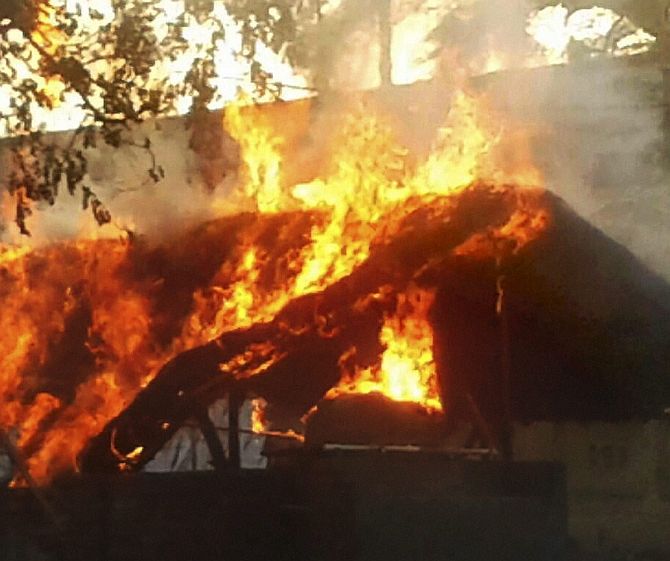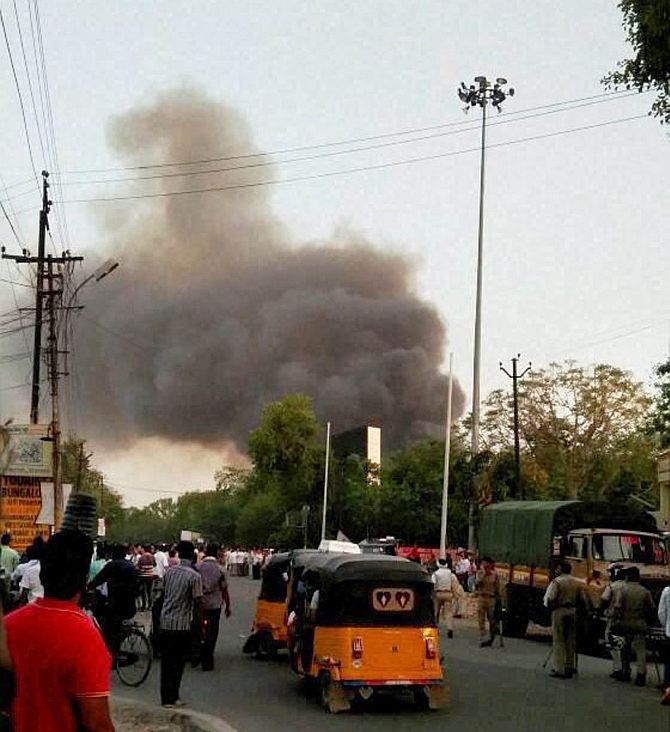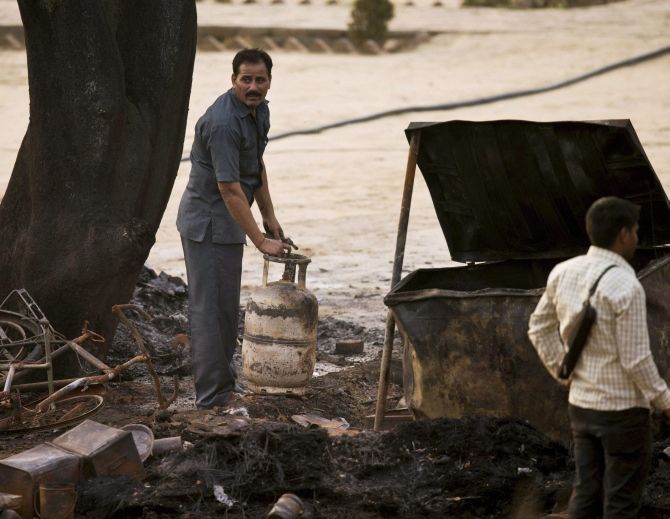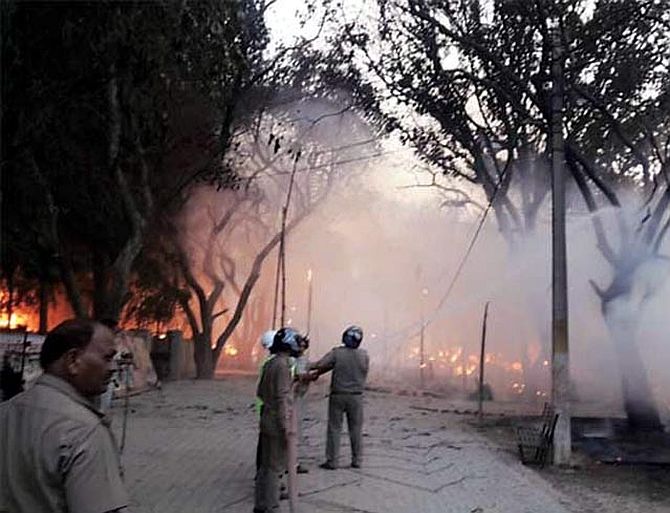When Superintendent of Police Mukul Dwivedi was beaten to death by a murderous SBVS mob, the killers included women and teenagers.
Why did the district magistrate take over an hour to order retaliatory firing on the murderous SBVS mob?
Rashme Sehgal reports from Mathura on the battle for Jawahar Bagh.

The Mathura police have launched a major cover-up operation so that their glaring lapses in the handling of the Swadhin Bharat Vidhik Satyagrah, SBVS, an organisation that swore allegiance to Netaji Subhas Chandra Bose.
A 3,000-strong armed SBVS contingent had been camping on the 270 acre Jawahar Bagh located in the heart of Mathura city next to the army cantonment, the tehsil complex and the city jail for the past two years. There, men, women and children were receiving training in arms, with no intervention by the police.
When Superintendent of Police Mukul Dwivedi was beaten to death by a lathi-wielding murderous SBVS mob on the evening of June 2, the killers included women and teenagers, both boys and girls.
Doctors at the local hospital who examined Dwivedi reported that he suffered 12 fractures on his skull and face. The bullet that killed Farah Station House Officer Santosh Yadav, who was trying to save Dwivedi's life, is reported to have been /fired by a woman.
City Magistrate Ram Araj Yadav -- who had accompanied Diwedi on a reconnisance mission on the evening of June 2 to see how the authorities could evict the SBVS squatters following an Allahabad high court directive ordering that they be forced to vacate government land, and who himself suffered injuries -- says, "Since we could not enter from the main gate, we decided to enter from the side and to do so, we used a JCB machine to break a part of a 5-foot wall."
"As we entered," City Magistrate Yadav recalled, "the mob inside pelted bricks and stones at us. Dwiwedi was hit by a brick. He fell, and within seconds he was attacked by rioters wielding lathis. My right arm was also hit by a brick and I suffered fractures."
The city magistrate admits that Dwivedi's gunner, whose job it was to protect the SP, fled for his life as did members of the Provincial Armed Constabulary -- comprising primarily fresh men and women recruits armed with plastic lathis who were no match for the well armed SBVS mob.

SBVS leader Ram Vriksh Yadav, who reportedly died in the subsequent battle with the police, had long boasted that he was training a 'Bhindranwale army', referring to Jarnail Singh Bhindranwale who had led an armed movement for Khalistan in Punjab in the early 1980s and perished in Operation Bluestar on June 6 32 years ago.
Viresh Yadav, Ram Vriksh Yadav's lieutenant, provided security training with groups of ten members patrolling the SBVS camp night and day.
Chandan Bose, his IT specialist, provided technical inputs. SBVS had cameras to photograph people entering and leaving the complex. None of its members were permitted to step outside the SBVS camp.
"When our PAC company recruits were entering the complex, we were armed with rubber bullets which we fired on these squatters," says City Magistrate Yadav, "but we were hardly in a position to take these people on."
Tthe key question being asked by Mathura residents is that despite having lost two senior police officers, why did the district magistrate take over an hour to order retaliatory firing on the murderous SBVS mob?
When District Magistrate Dr Rajesh Kumar and Senior Superintendent of Police Dr Rakesh Singh were asked this question, they replied almost in unison, "The state government has ordered an enquiry being headed by Commissioner of Police Chandra Kant heading the Aligarh district. All questions must now be directed to him."
Chandra Kant was equally evasive. "I have just stared my enquiry," he said, adding, "I have spoken to officials in the administration and independent observers, I plan to submit my report to the state government within the next 15 days."
Once District Magistrate Dr Rajesh Kumar gave permission for the police to retaliate, residents living in the colonies adjacent to Jawahar Bagh confirm that the firing went on for 90 minutes, between 5.30 pm and 7 pm.
The non stop firing was followed by loud explosions caused by exploding gas cylinders and grenades.
"The police have been telling us that they have recovered 29 dead bodies. We understand that around 300 people who were injured are being treated in the local district hospital," says Kunwar Narendra Singh, one of the tallest political leaders in Mathura, adding, "our suspicion is that between 300 to 500 people would have died in this operation."
"But since the people living there were not locals and were brought there from Madhya Pradesh and eastern Uttar Pradesh," he said, "we have little idea about their antecedents."

Local sources confirm that the death toll is much higher than the figure of 29 being claimed by the police.
Commissioner of Police Chandra Kant insists that the death toll is 23, but locals say over 25 SBVS men trying to escape were lynched by angry residents, incensed by Dwivedi and Yadav's deaths.
Narendra Singh helped set up the Jawahar Bagh Sangarsh Samiti whereby a group of 30 to 40 government staffers held protests outside the collectorate, demanding that the SBVS encroachers be evicted. Their offices were located inside Jawahar Bagh including office belonging to the state horticulture and agriculture departments.
Once the encroachers had settled on this land inside Jawahar Bagh, they did not allow outsiders to enter. Fearing retaliation by the SBVS encroachers, the authorities forced Samiti members to hold their protests at another site.
"The government knew from the start that they were a bad lot," says Narendra Singh. "When a group of patwaris went there, they were beaten up. Later, they destroyed a part of the tehsil and yet no action was taken against them."
"Following the Allahabad high court order, a team of PAC jawans led by Chakrapani Tripathi went to persuade Ram Vriksh Yadav to vacate the premises," Narendra Singh adds. "A media team went with Tripathi. Ram Vrikish Yadav's men gheraoed these people and did not release them for an hour. The writing was clear on the wall. This was a dangerous vigilante group."

"Whenever Ram Vriksh Yadav stepped out of Jawahar Bagh, he used to strut around with a team of armed guards. How was he allowed to build up this private army?" Narendra Singh asks.
He also questions how Ram Vriksh Yadav was paid a government pension of Rs 15,000 each month. "How were these squatters given Aadhar cards? Who was financing this group because not only were trucks carrying food items reaching the site every day, but this group had also started a daily bazaar where they sold vegetables and fruits at half rates."
Ram Vriksh Yadav's SBVS is a splinter group of a sect run by Jai Gurudev who came to Mathura from Etawah in 1968 and who allegedly secured land in a similar manner. The land was apart of the UP state industrial area where Gurudev built a massive ashram which bore a resemblance to the Taj Mahal. He was said to be close to Samajwadi party founder Mulayam Singh Yadav and his brothers.
Ram Vriksh Yadav appeared to have government contacts as well. In 2014, the then DM reportedly provided the squatters with an electricity connection. His contacts in Lucknow, Mathura residents allege, had assured him that the Jawahar Bagh land would be transferred to him at the nominal rate of Rs one per square foot.
There are precedents of such transfers -- Sadhvi Ritambara was reportedly given a large tract of land in Mathura at nominal rates by then UP chief minister Kalyan Singh.
Were it not for the public interest litigation filed by local advocate Vijay Pal Tomar, the SBVS plan could well have succeeded.
"They wanted to grab government land and our city would have lost one of its most beautiful parks. As it is, following the massive fire, the entire park with its trees and orchards has been burnt to ashes," says Tomar.
Questions about the police operation are being openly asked in the city. Officials in the state intelligence wing had issued several warnings to the local administration about the weaponry that had been acquired by the SBVS sect. All these warnings went unheeded.
Residents from the colonies overlooking Jawahar Park say over 100 ambulances were requisitioned from Agra and Aligarh to carry the injured on the fatal night of June 2. Independent observers wonder if dead bodies were ferried out of the city because the ambulances worked through the night.
"How was the police allowed to carry out such a botched out operation?" asks Narendra Singh. "If the police had wanted to carry out a recee, they should have gone about it in a quiet manner without alerting Ram Vriksh Yadav's group."









